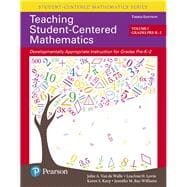About This Book
Teaching Student-Centered Mathematics: Developmentally Appropriate Instruction for Grades Pre-K-2 (Volume 1)
This book is a comprehensive guide designed for classroom teachers aiming to create a student-centered environment in mathematics education. It focuses on grades Pre-K-2, providing practical strategies for teaching mathematics in a way that connects with students' everyday lives.
Who Uses It?
Primarily, this book is used by elementary school teachers and educators who are looking to implement student-centered approaches in their mathematics classrooms. It is also a valuable resource for education students and professionals interested in early childhood education and mathematics instruction.
History and Editions
The third edition of "Teaching Student-Centered Mathematics" was released on January 9, 2017. This edition has been updated to reflect the latest teaching practices and standards, including the Common Core State Standards and NCTM’s teaching practices. The book has been widely popular among educators for its practical and comprehensive approach to student-centered mathematics instruction.
Author and Other Works
The authors of this book are John Van de Walle, LouAnn Lovin, Karen Karp, and Jennifer Bay-Williams. John Van de Walle is renowned for his contributions to mathematics education, particularly in the area of student-centered instruction. The other authors bring their expertise in early childhood education and mathematics pedagogy to the text, ensuring it remains current and relevant.
Detailed Information
ISBNs and Formats
- ISBN-13: 9780134556437
- ISBN-10: 0134556437
- eBook: Available through various online retailers (check with the seller for access codes)
- Rental Options: Various rental durations available from different retailers
Publication Details
- Publisher: Pearson
- Publication Date: January 9, 2017
- Number of Pages: 496 pages
- Language: English
Other Editions and Formats
- Related ISBNs:
- 9780134081403
- 9780134081434
- 9780134081458
- 9780134556451
- 0134081439
- 0134081455
Key Features
- Student-Centered Approach: Focuses on creating an effective classroom environment where students can become mathematically proficient.
- Alignment with Standards: Aligns teaching to various standards and practices, such as the Common Core State Standards and NCTM’s teaching practices.
- Engaging Families: Includes strategies for engaging families in their children's mathematics education.
- Enhanced Pearson eText: Features a corresponding Enhanced Pearson eText version with links to embedded videos, blackline masters, downloadable teacher resources, and activity pages.
This detailed information section provides a quick reference for all the available formats and sources for "Teaching Student-Centered Mathematics," making it easier to find and access the book in the preferred format.









